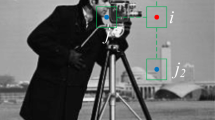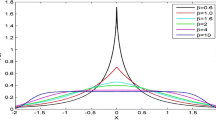Abstract
Image segmentation is a significant research topic in image processing and computer vision. Active contour methods (ACMs) are widely used in image segmentation. In this paper, a new hybrid ACM segmentation model based on Chan–Vese (C–V) and Local Gaussian Distribution Fitting (LGDF) methods is proposed for the images with intensity inhomogeneity. In this model, new gradient descent flow equations are proposed and applied for the energy minimization of C–V and LGDF methods. Firstly, the proposed C–V method is applied to the image to effectively and quickly find the homogeneous regions of the image. Then, the proposed LGDF method is performed in these regions to detect inhomogeneous areas of the image. Thus, more effective and successful segmentation is obtained for inhomogeneous images. Experimental results show that the satisfactory segmentation results have been obtained by the proposed method for MRI and real images. Also, the proposed method is compared with the local binary fitting, LGDF, adaptive local-fitting-based, global and local weighted signed pressure ACMs, and convolutional neural network-based methods.






Similar content being viewed by others
References
Pratondo, A., Chui, C.K., Ong, S.H.: Integrating machine learning with region-based active contour models in medical image segmentation. J. Visual Commun. Image Represent 43, 1–9 (2017)
Akram, F., Garcia, M.A., Puig, D.: Active contours driven by local and global fitted image models for image segmentation robust to intensity inhomogeneity. PloS One 12(4), e0174813 (2017)
Rodtook, A., Kirimasthong, K., Lohitvisate, W., Makhanov, S.S.: Automatic initialization of active contours and level set method in ultrasound images of breast abnormalities. Pattern Recognit. 79, 172–182 (2018)
Niu, S., Chen, Q., De Sisternes, L., Ji, Z., Zhou, Z., Rubin, D.L.: Robust noise region-based active contour model via local similarity factor for image segmentation. Pattern Recognit. 61, 104–119 (2017)
Duan, Y., Peng, T., Qi, X.: Active contour model based on lif model and optimal dog operator energy for image segmentation. Optik 202, 163667 (2020)
Ma, D., Liao, Q., Chen, Z., Liao, R., Ma, H.: Adaptive local-fitting-based active contour model for medical image segmentation. Signal Process. Image Commun. 76, 201–213 (2019)
Jatoi, M.A., Kamel, N.: Brain source localization using reduced EEG sensors. Signal Image Video Process. 12(8), 1447–1454 (2018)
Kass, M., Witkin, A., Terzopoulos, D.: Snakes: active contour models. Int. J. Comput. Vis. 1(4), 321–331 (1988)
Gupta, D., Anand, R.: A hybrid edge-based segmentation approach for ultrasound medical images. Biomed. Signal Process. Control 31, 116–126 (2017)
Liu, C., Liu, W., Xing, W.: A weighted edge-based level set method based on multi-local statistical information for noisy image segmentation. J. Visual Commun. Image Represent 59, 89–107 (2019)
Chan, T.F., Vese, L.A.: Active contours without edges. IEEE Trans. Image Process. 10(2), 266–277 (2001)
Lie, J., Lysaker, M., Tai, X.C.: A binary level set model and some applications to Mumford–Shah image segmentation. IEEE Trans. Image Process. 15(5), 1171–1181 (2006)
Li, C., Kao, C.Y., Gore, J.C., Ding, Z.: Implicit active contours driven by local binary fitting energy. In: 2007 IEEE Computer Society Conference on Computer Vision Pattern Recognition, pp. 1–7. IEEE (2007)
Wang, L., He, L., Mishra, A., Li, C.: Active contours driven by local gaussian distribution fitting energy. Signal Process. 89(12), 2435–2447 (2009)
Peng, Y., Liu, S., Qiang, Y., Wu, X., Hong, L.: A local mean and variance active contour model for biomedical image segmentation. J. Comput. Sci. Eng. 33, 11–19 (2019)
Wang, L., Chang, Y., Wang, H., Wu, Z., Pu, J., Yang, X.: An active contour model based on local fitted images for image segmentation. Inf. Sci. 418, 61–73 (2017)
Liu, S., Peng, Y.: A local region-based Chan–Vese model for image segmentation. Pattern Recognit. 45(7), 2769–2779 (2012)
Wang, H.J., Liu, M.: Active contours driven by local gaussian distribution fitting energy based on local entropy. Int. J. Pattern Recognit Artif Intell. 27(06), 1355008 (2013)
Zhang, K., Zhang, L., Song, H., Zhou, W.: Active contours with selective local or global segmentation: a new formulation and level set method. Image Vision Comput. 28(4), 668–676 (2010)
Wang, H., Huang, T.Z., Xu, Z., Wang, Y.: A two-stage image segmentation via global and local region active contours. Neurocomputing 205, 130–140 (2016)
Zhang, L., Peng, X., Li, G., Li, H.: A novel active contour model for image segmentation using local and global region-based information. Mach Vis Appl. 28(1–2), 75–89 (2017)
Han, B., Wu, Y.: Active contours driven by global and local weighted signed pressure force for image segmentation. Pattern Recognit. 88, 715–728 (2019)
Vakili, N., Rezghi, M., Hosseini, S.M.: Improving image segmentation by using energy function based on mixture of Gaussian pre-processing. J. Visual Commun. Image Represent 41, 239–246 (2016)
Soomro, S., Munir, A., Choi, K.N.: Hybrid two-stage active contour method with region and edge information for intensity inhomogeneous image segmentation. PloS One 13(1), e0191827 (2018)
Zhao, F., Liang, H., Wu, X., Ding, D.: Active contour segmentation model based on global and local Gaussian fitting: Electronic Engineering. Electronic Engineering, pp. 43–48. CRC Press, Boca Raton (2018)
Liu, L., Ouyang, W., Wang, X., Fieguth, P., Chen, J., Liu, X., Pietikäinen, M.: Deep learning for generic object detection: a survey. Int. J. Comput. Vision 128(2), 261–318 (2020)
Garcia-Garcia, A., Orts-Escolano, S., Oprea, S., Villena-Martinez, V., Garcia-Rodriguez, J.: A review on deep learning techniques applied to semantic segmentation. arXiv preprint arXiv:1704.06857 (2017)
Jatoi, M.A., Dharejo, F.A., Teevino, S.H.: Comparison of machine learning techniques based brain source localization using EEG signals. Curr. Med. Imag. (2020). https://doi.org/10.2174/1573405616666200226122636
Long, J., Shelhamer, E., Darrell, T.: Fully convolutional networks for semantic segmentation. In: Proceedings IEEE Computer Society Conference Computer Vision Pattern Recognition, pp. 3431–3440 (2015)
Ronneberger, O., Fischer, P., Brox, T.: U-net: Convolutional networks for biomedical image segmentation. In: International Conference on Medical Image Computing and Computer-Assisted Intervention (pp. 234-241). Springer, Cham
He, K., Gkioxari, G., Dollár, P., Girshick, R.: Mask rcnn. arxiv e-prints, article. arXiv preprint arXiv:1703.06870 (2017)
Chen, L.C., Papandreou, G., Kokkinos, I., Murphy, K., Yuille, A.L.: Deeplab: Semantic image segmentation with deep convolutional nets, atrous convolution, and fully connected crfs. IEEE Trans. Pattern Anal. Mach. Intell. 40(4), 834–848 (2017)
Chen, L.C., Papandreou, G., Schroff, F., Adam, H.: Rethinking atrous convolution for semantic image segmentation. arXiv preprint arXiv:1706.05587 (2017)
Guo, X., Schwartz, L.H., Zhao, B.: Automatic liver segmentation by integrating fully convolutional networks into active contour models. Med. Phys. 46(10), 4455–4469 (2019)
Zhu, X., Wei, Y., Lu, Y., Zhao, M., Yang, K., Wu, S., Zhang, H., Wong, K.K.: Comparative analysis of active contour and convolutional neural network in rapid left-ventricle volume quantification using echocardiographic imaging. Comput. Methods Programs Biomed. 199, 105914 (2020)
Li, C., Kao, C.Y., Gore, J.C., Ding, Z.: Minimization of region-scalable fitting energy for image segmentation. IEEE Trans. Image Process. 17(10), 1940–1949 (2008)
Brainweb: Simulated brain database. http://www.bic.mni.mcgill.ca/brainweb/. Accessed 06 Feb 2020
Berkeley Image Segmentation Database. https://www2.eecs.berkeley.edu/Research/Projects/CS/vision/bsds/. Accessed 06 Feb 2020
Author information
Authors and Affiliations
Corresponding author
Additional information
Publisher's Note
Springer Nature remains neutral with regard to jurisdictional claims in published maps and institutional affiliations.
Rights and permissions
About this article
Cite this article
Ozturk, N., Ozturk, S. A new effective hybrid segmentation method based on C–V and LGDF. SIViP 15, 1313–1321 (2021). https://doi.org/10.1007/s11760-021-01862-0
Received:
Revised:
Accepted:
Published:
Issue Date:
DOI: https://doi.org/10.1007/s11760-021-01862-0




